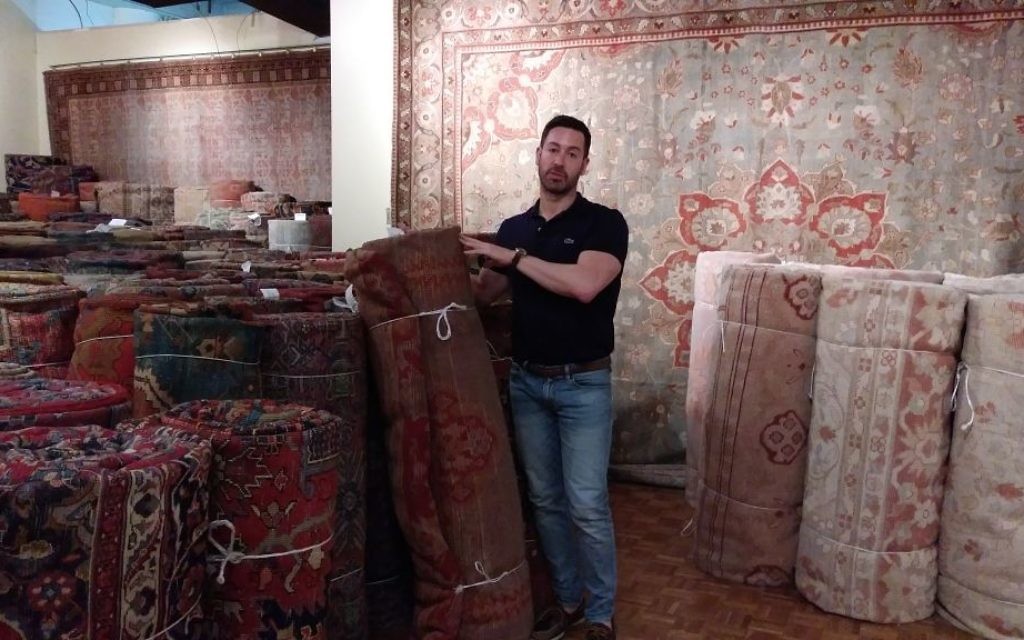Moattar Family Keeps Weaving Legacy in Rugs
Andrea and Jason continue the family business selling antique rugs.

When Eddie Moattar died 13 years ago, his two children took over Moattar Ltd. Finer Rugs, the business he launched in 1963 and ran for 40 years.
Eddie came to the United States in the early 1960s after running a department store named Blue Star in Iran. When the political climate shifted, he set his sights on the American dream, and he and his wife, Marcia, married in 1966, built an Atlanta empire based on antique rugs.
Moattar rugs can be found from the White House to Buckhead’s St. Regis.
Get The AJT Newsletter by email and never miss our top stories Free Sign Up
“When we got married, I said, ‘What am I going to do all day?’ ” Marcia said. “He said, ‘Come to work with me.’ ”
Eddie opened his first location, House of Persia, in Decatur, then a second location on East Paces Ferry Road in Buckhead. The family eventually opened another store on Miami Circle and a showroom at ADAC on Peachtree Hills Road.
After five years of marriage, the couple had a daughter, Andrea, and five years later a son, Jason.
Jason is now the president of Moattar, and Andrea is the CEO. Andrea said her father’s vision is what persuaded her to continue his legacy.
“I love art, and I studied art history, but when I moved back to Atlanta, I applied at different art galleries and realized I wasn’t going to make any more money than what I made in high school,” Andrea said. “I talked to my father about it and he said, ‘You have no idea what you have under your nose. This is an art gallery, except this type of art is woven, not drawn.’ ”
She now sees that her father was grooming his children to handle his affairs in his absence and made the transition easy for them. “A lot of times it’s hard for parents to let go, but he trusted me to make the decisions on things like trends young people may like,” Andrea said. “He never held us back.”
Now Andrea and Jason spend their time attending trade shows and traveling to purchase rugs for their clients. Moattar is a trade-show-only showroom, meaning the company sells only to interior designers and architects buying for their clients.

It’s a smoother process than selling directly to consumers, who might ask to see 20 rugs and still not know what they want, Jason said.
“Our bread and butter are our designers,” he said. “In order to purchase something like this, you need to have somebody who has a bigger idea of what they’re doing for you. That’s why it’s great to work with designers because they know what they want.”
Interior designers can choose from an array of contemporary rugs in wool or silk and even customize colors.
Despite the traditional appeal of antique Persian rugs, Andrea said more contemporary rugs are popular because of their versatility. Moattar is bringing in a line from Iran made with bigger knots because such rugs are getting triple the price of those with smaller knots.
It’s the ability to stay on top of trends and navigate the market that keeps the Moattars relevant.
Walking through the showroom, Jason explained that selling rugs is like selling art.
“The more craftsmanship and the time it takes to weave it, the more expensive it’s going to be. But in antique rugs, it depends on the demand, and right now there is a demand for more contemporary rugs,” he said. “An antique rug in traditional colors can sell for about $20,000. An antique in warm and red colors is going to be less expensive, but a rug made in Turkey is about $45,000, and that’s not that bad. Turkish rugs are more in demand, and they’re all treated like art, so the prices are going to be different.”
The showroom walls are lined with antique rugs from Turkey, China, India and Pakistan. While the popularity of Turkish rugs is making them some of the pricier finds on the showroom floor, people are still paying top prices for Persian rugs, Jason said.
“Someone just came in and paid $135,000 for a Persian rug that took two years to make and we had in the showroom for over 20 years,” Jason said. “Some of the rugs here are over 150 years ago. Some of the Persian rugs here that were made for the French are over 120 years old, but because they have pinks and blacks, they’re not desirable, so that drives the cost down.”
Age is not typically the first thing the Moattars look at when buying for the showroom. They usually find antique rugs through brokers, auctions and trade shows.
The siblings leave the buying to brokers because the political climate in many of the countries where the rugs are woven makes traveling unsafe, Andrea said.
“In Afghanistan and Pakistan, we would have to stay in a compound and have heavy security,” Andrea said. “I have a Persian last name with an American passport, and on top of everything else we’re Jewish.”
Eddie was the only one in the family who traveled to Iran to purchase rugs, and despite getting into fights on the way to school for being Jewish, he held on to his Jewish heritage. Living the American dream was about giving his children the opportunity to experience freedom.
“My dad loved this country so much. He wanted me and Jason to be fully assimilated, so he gave us American names,” Andrea said. “He was proud to be Jewish. Being Jewish and Judaism were important to him.”





comments